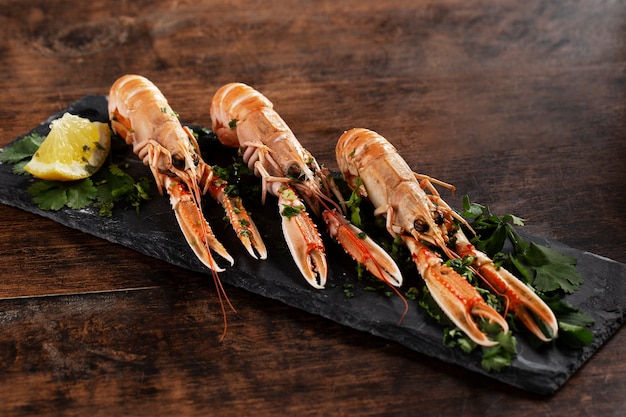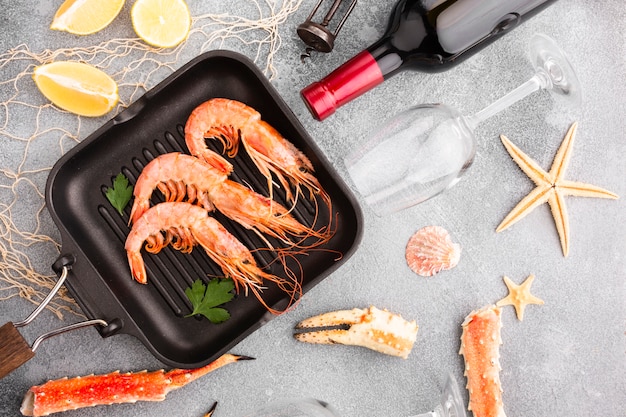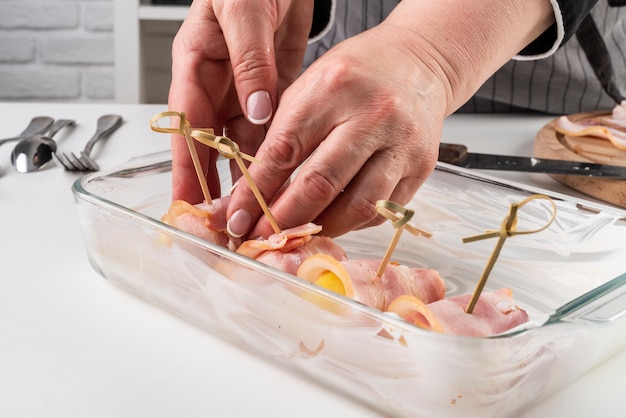lobster tails, oh lobster tails. Just the thought of their succulent, sweet flesh makes my mouth water. There’s something truly special about cracking open a perfectly cooked lobster tail, feeling the steam rise from the meat, and relishing the sweet, delicate flavour. It's a culinary experience that never fails to impress, and let's be honest, it's a dish that screams "celebration!" Whether you're a seasoned seafood aficionado or a curious newbie, mastering the art of cooking lobster tails can feel a bit daunting. But fear not, my friends! This guide is your ultimate companion to unlock the secrets of achieving that perfect, melt-in-your-mouth lobster tail, every single time.
Part 1: The Lobster Lowdown - Choosing Your Prize

First things first, let's talk lobster tails. They're not all created equal, and choosing the right ones is the first step to achieving lobster tail nirvana. You want to make sure you're getting the freshest, most succulent tails possible, and for that, you need to know what to look for.
Finding the Freshest Catch
As a rule of thumb, I always try to buy lobster tails from a reputable fishmonger or seafood market. These experts know their stuff and can guide you towards the freshest, highest-quality tails. If you’re lucky enough to live near the coast, you might even find a local fisherman who can supply you with fresh, freshly caught lobster tails - that's a true taste of the ocean! Avoid buying lobster tails from supermarkets unless they're clearly labelled as "fresh" and have a good “sell by” date. You're after that bright, vibrant colour and a firm, springy texture. Avoid any tails that look dull, discoloured, or mushy - those are signs of a tail that's past its prime.
Decoding lobster tail sizes
Lobster tails come in various sizes, and the size usually indicates the price. Here's a quick guide to help you navigate the world of lobster tail sizes:
- Small: These are usually less than 6 ounces and are great for smaller meals or as an appetizer. Think of them as a delightful little starter to whet your appetite for the main event.
- Medium: These range from 6 to 10 ounces and are a good option for a single serving or a smaller group. Perfect for a satisfying, individual meal or a casual get-together with friends.
- Large: These are 10 ounces or more and are perfect for a hearty meal or sharing. These are the granddaddies of lobster tails, perfect for a celebratory feast or a family dinner.
The Secret of Weight
When it comes to lobster tails, the weight is a crucial indicator of the amount of edible meat you'll get. Larger tails obviously yield more meat, but remember, the price often reflects that size. Weighing a few different tails can help you get the best value for your money. For example, if you're planning a dinner party for six people, you might want to buy two large lobster tails and two medium tails, ensuring enough meat for everyone without breaking the bank.
Part 2: Prepping Your Lobster Tails – The Perfect First Steps

Okay, you’ve got your lobster tails, now what? Before you embark on your culinary adventure, there are a few crucial prep steps to take. These steps might seem simple, but they can make a huge difference in the final taste and texture of your cooked lobster tails. They're like the foundation of a great house - if you don't get them right, the rest of the building will be shaky!
Thawing Time
If you've purchased frozen lobster tails, proper thawing is vital. The worst thing you can do is rush the thawing process. Never thaw lobster tails at room temperature, as this can encourage bacterial growth. Instead, opt for a slow, gentle thawing in the refrigerator overnight. This allows the lobster tails to thaw evenly, preserving their delicate flavour and texture.
A Little Rinse Goes a Long Way
Once your lobster tails are thawed, give them a good rinse under cold running water. This helps to remove any impurities or lingering ice crystals, and it also ensures that the lobster tails are nice and clean before cooking. Think of it like giving your lobster tails a refreshing spa treatment before their big culinary debut!
The Magic of Brine
Now, here’s a little secret I’ve learned over the years: brining your lobster tails before cooking adds an extra layer of flavour and moisture. Simply create a brine solution by dissolving a generous amount of salt in a large bowl of cold water. Submerge your lobster tails in the brine and let them soak for at least 30 minutes, or up to an hour. This process helps to plump up the flesh and enhance the natural sweetness of the lobster. It's like giving your lobster tails a little boost of hydration and flavour before they hit the heat!
Part 3: Cooking Methods – Exploring the Options

There are several methods for cooking lobster tails, each with its own unique flavour profile and texture. I've experimented with various techniques over the years, and I'm happy to share my tried and true methods with you. Each method brings its own personality to the table, so you can choose the one that best suits your taste and culinary style.
The Classic Steaming Method: A Simple Approach
Steaming is a classic method for cooking lobster tails that delivers a clean, delicate flavour. It's like giving your lobster tails a gentle spa treatment, letting them cook in their own natural juices. You’ll need a large pot with a steamer insert. Fill the pot with about an inch of water, add a few bay leaves and peppercorns for extra flavour, and bring it to a simmer. Place the lobster tails in the steamer basket and cover the pot with a lid. Steam the lobster tails for about 10-12 minutes, depending on their size. You’ll know they’re done when the flesh is opaque and easily pulls away from the shell.
Grilling for That Smoky Flavour
If you’re looking for a more intense flavour, grilling is the way to go. It's like giving your lobster tails a little campfire experience, adding a smoky depth to their flavour. Preheat your grill to medium heat. Lightly brush the lobster tails with olive oil and season them with salt, pepper, and your favourite herbs. Place the lobster tails on the grill and cook for about 5-7 minutes per side, or until the flesh is cooked through and slightly charred. Grilling adds a fantastic smoky flavour to the lobster, and it’s a great way to enjoy it outdoors.
Baking for Even Cooking
Baking is another simple and reliable method for cooking lobster tails. It's a great option if you're looking for a more hands-off approach, letting the oven do its magic. Preheat your oven to 400 degrees Fahrenheit (200 degrees Celsius). Place the lobster tails on a baking sheet lined with parchment paper. Drizzle them with melted butter and season with salt and pepper. Bake for 10-15 minutes, or until the flesh is opaque and cooked through.
Boiling for Simplicity
boiling lobster tails is the most straightforward method, and it's a great option if you're short on time. Think of it as the quick and easy route to delicious lobster tails. Fill a large pot with water and add a few bay leaves and peppercorns. Bring the water to a rolling boil, then add the lobster tails. Cook for 8-10 minutes, or until the flesh is opaque and easily pulls away from the shell.
Part 4: The Art of Presentation – A Culinary Showcase
You’ve put in the effort to cook perfect lobster tails, now it's time to showcase them beautifully! A simple and elegant presentation can elevate your lobster tails from a delicious meal to a culinary masterpiece. Think of it as the finishing touch that makes your lobster tails look as good as they taste.
A Dash of Colour and Texture
I love to add a bit of colour and texture to my lobster tail presentation. A simple garnish of fresh parsley, lemon wedges, or a drizzle of melted butter adds a touch of visual appeal. You could also incorporate some grilled vegetables, like asparagus or bell peppers, for a vibrant contrast. It's like adding a splash of personality to your lobster tail dish.
Serving Styles
When it comes to serving lobster tails, there are a few classic styles you can choose from. Each style brings a different vibe to the table, allowing you to match the presentation to your occasion.
- On a Platter: Arrange the cooked lobster tails on a platter, alongside your favourite accompaniments, such as drawn butter, lemon wedges, and herbs. This is a perfect option for a casual dinner or party. It's a relaxed, communal way to enjoy lobster tails, perfect for sharing with friends and family.
- Individual Plates: Serve each lobster tail on its own individual plate, with a side of your favourite sauce or salad. This creates a more formal and elegant presentation. It's a sophisticated option for special occasions or a romantic dinner for two.
Part 5: The Perfect Pairings – side dishes and Sauces
Lobster tails are incredibly versatile and pair well with a wide variety of side dishes and sauces. The key is to find flavour combinations that complement the delicate sweetness of the lobster without overpowering it. Think of it as finding the perfect dance partners for your lobster tails, creating a harmonious symphony of flavours.
Classic Side Dishes
- roasted asparagus: The earthy flavour of asparagus is a perfect match for the sweetness of lobster tails. They're like two good friends who bring out the best in each other.
- corn on the cob: The sweetness of corn on the cob complements the lobster beautifully. It's a classic pairing that never fails to please.
- Creamy Risotto: A creamy risotto with lemon zest provides a satisfying contrast to the lobster's delicate texture. The risotto is a comforting and creamy hug for the lobster, a perfect match made in culinary heaven.
- Green Salad: A simple green salad with a light vinaigrette adds freshness and lightness to your lobster meal. It's a refreshing counterpoint to the richness of the lobster, bringing balance and lightness to the dish.
Sauce Sensations
Lobster tails can be enhanced with a variety of sauces, but I'll stick with a few timeless favourites. These sauces are like the cherry on top of a perfect lobster tail sundae, adding a touch of magic and flavour.
- Melted Butter: This is the classic pairing for lobster tails. Simply melt a knob of butter and serve it alongside the lobster. You can also add a squeeze of lemon juice and a sprinkle of fresh herbs to the melted butter for extra flavour. It's the simplest yet most satisfying way to enjoy lobster tails, allowing the natural sweetness of the lobster to shine through.
- Lemon-Garlic Sauce: A simple lemon-garlic sauce adds a bright and tangy flavour to the lobster. Combine melted butter, lemon juice, minced garlic, and a pinch of red pepper flakes. It's a zesty and aromatic sauce that wakes up the taste buds.
- Béarnaise Sauce: A rich and creamy béarnaise sauce adds a sophisticated touch to lobster tails. It's a classic French sauce that adds a touch of elegance and refinement to any lobster dish.
Part 6: Lobster Tails Beyond the Plate – Exploring Other Options
Lobster tails aren't just for elegant dinners! They can be incorporated into a variety of dishes, adding a touch of luxury and flavour. Think of them as a secret ingredient that can elevate any dish to new heights of deliciousness.
lobster rolls – A Coastal Delight
Lobster rolls are a classic summertime treat, particularly on the east coast of the United States. They are typically made with chopped lobster meat, mayonnaise, and a touch of celery, served on a toasted hot dog bun. It's a casual and flavourful way to enjoy lobster, perfect for picnics, beach days, or a quick and easy lunch.
lobster mac and cheese – A Gourmet Twist
Elevate your macaroni and cheese to new heights with the addition of lobster. Simply toss cooked lobster meat with your favourite mac and cheese recipe for a truly decadent meal. It's a comfort food classic with a touch of luxury, perfect for a special occasion or a cozy night in.
Lobster Pasta – A Taste of Italy
Lobster pasta dishes are a popular choice in many Italian restaurants. The lobster's delicate flavour pairs beautifully with the creamy sauce of a lobster ravioli or the vibrant tomato sauce of a lobster spaghetti. It's a sophisticated and flavourful dish that combines the best of Italian cuisine with the luxury of lobster.
Part 7: FAQs – Common Lobster Tail Questions Answered
You’ve got your lobster tails, you’re ready to cook them, but maybe you have a few lingering questions. Don't worry, I've got you covered! Here are some of the most common questions about lobster tails, answered with a touch of personal experience.
How Do I Know When Lobster Tails are Cooked?
The best way to tell if your lobster tails are cooked through is to check the flesh. It should be opaque and firm, and it should easily pull away from the shell. You can also use a meat thermometer. Insert the thermometer into the thickest part of the flesh, and it should read between 140 and 145 degrees Fahrenheit (60-63 degrees Celsius).
Can You Overcook lobster tails?
Yes, you can overcook lobster tails. Overcooked lobster tails will be tough and rubbery. It's best to err on the side of undercooking, as you can always cook them a bit longer if needed. Overcooked lobster tails are a culinary tragedy, so it's better to be safe than sorry!
Can I Freeze Lobster Tails?
You can freeze lobster tails, but it's best to do it before they've been cooked. Wrap them tightly in plastic wrap and aluminum foil, then place them in a freezer-safe bag. Lobster tails can be frozen for up to 3 months. Just make sure to thaw them completely in the refrigerator before cooking. This will help to preserve the quality and flavour of the lobster tails.
What Should I Do With the Lobster Shell?
You can save the lobster shell to make a delicious lobster stock! Simply add the shells to a pot of water with a few vegetables, like carrots and onions. Bring the mixture to a boil, then reduce the heat and simmer for about an hour. Strain the stock and use it to make soups, sauces, or risottos. It's a great way to use every part of the lobster and create a flavourful base for other dishes.
How Do I Eat Lobster Tails?
There are a few ways to eat lobster tails. You can use a lobster cracker to crack open the shell and extract the meat. Or, you can use your fingers to pull the meat away from the shell. If you're using a lobster cracker, be careful not to use too much force, as the shell can shatter. Lobster crackers are a fun and efficient way to eat lobster tails, but if you're feeling adventurous, you can always use your hands!
Part 8: A culinary journey – My Personal Lobster Tail Story
I've been cooking lobster tails for years now, and I've learned a lot along the way. One of my favourite memories involves a special dinner I prepared for my family. It was a summer evening, and the air was filled with the scent of fresh-cut grass and blooming flowers. I had just bought a beautiful batch of fresh lobster tails from the local fishmonger, and I was excited to impress everyone with my culinary skills.
I decided to go with a classic grilling method, using a combination of herbs and spices. As the lobster tails cooked, the aroma of grilling seafood filled the air, making everyone's mouths water. When the lobster tails were perfectly cooked, I presented them on a platter with a side of melted butter, lemon wedges, and a simple green salad. The compliments came pouring in, and I knew I had created a truly memorable meal.
Cooking lobster tails is more than just a recipe; it's about creating an experience. It's about sharing a delicious meal with loved ones, celebrating special occasions, and enjoying the simple pleasures of good food. So go forth, my friends, and embark on your own lobster tail journey! With this guide in hand, you'll be well on your way to mastering the art of cooking this delectable seafood delicacy.
Everyone is watching

How to Cook Frozen Lobster Tails Perfectly: A Step-by-Step Guide
RecipesLobster. Just the word conjures up images of lavish meals, special occasions, and a taste of luxury. But let's...

Pigs in a Blanket Cooking Time: How Long to Bake for Perfect Results
RecipesAh, pigs in a blanket. Just the name conjures up images of those delightful little parcels of crispy pastry en...

Pork Fillet Cooking Time: How Long to Cook It Perfectly
RecipesPork fillet, or tenderloin as it's sometimes called, is a real favourite in our house. It's so versatile, and...

The Ultimate Guide to Cooking Delicious Frankfurters
RecipesLet's face it, we all love a good frankfurter. It's a classic, simple, and always satisfying. But let's be rea...

Wolf Meat Recipes: A Guide to Cooking Wild Game
RecipesLet's be honest, you don't see wolf meat at your local butcher shop every day. It's a bit of a wild card, but ...
